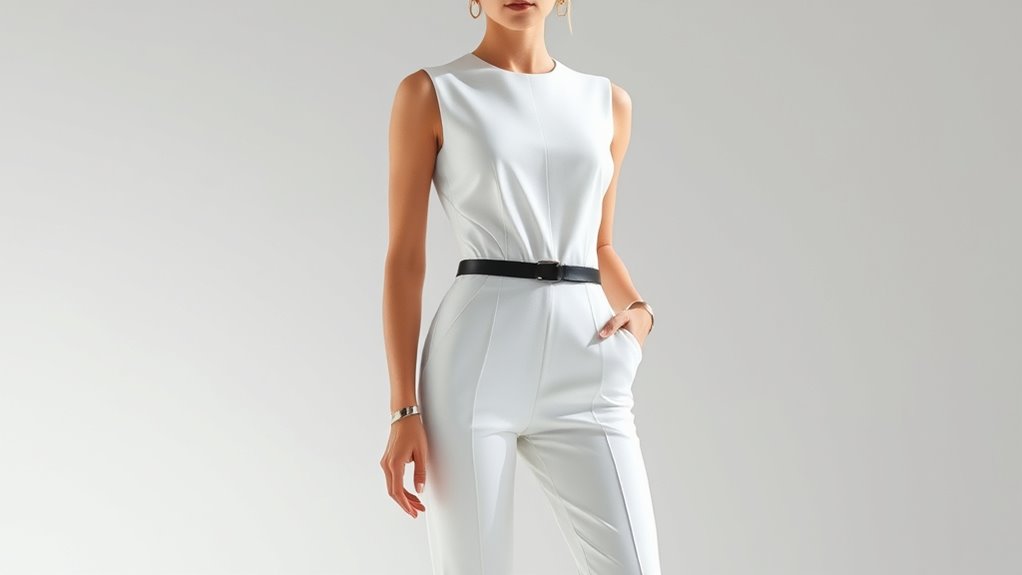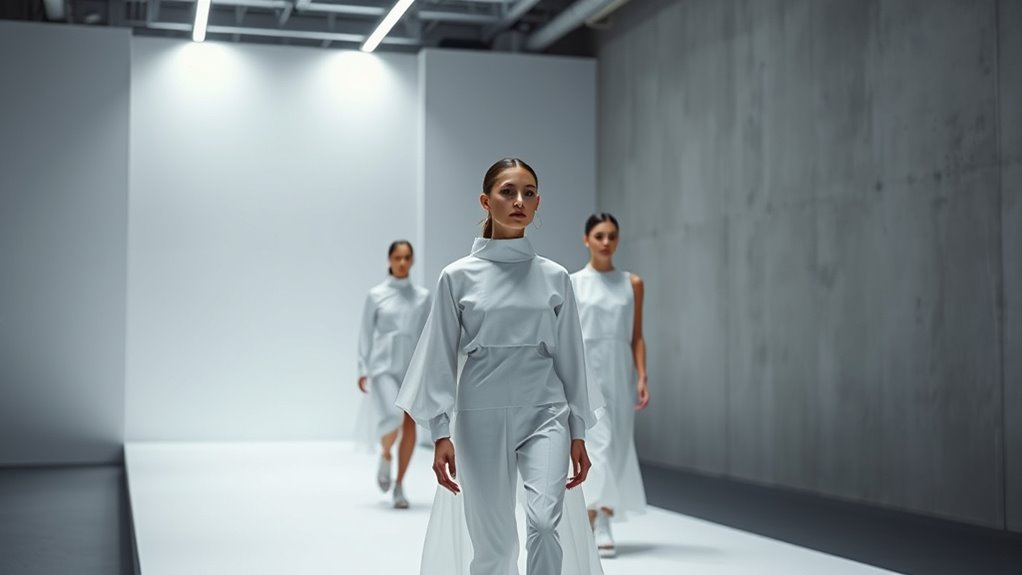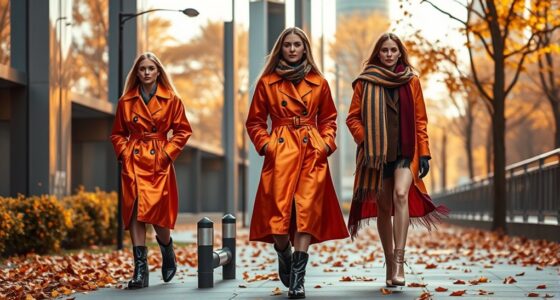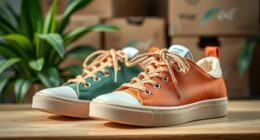By 2025, minimalist aesthetics will shape your wardrobe with sustainable, high-quality pieces made from eco-friendly materials like organic cotton and recycled fabrics. You’ll enjoy clean lines, versatile designs, and timeless styles that focus on durability and craftsmanship. Virtual fashion shows will let you explore collections from anywhere, highlighting transparency and responsible practices. If you’re curious about how this shift impacts your style and choices, you’ll find plenty more insights ahead.
Key Takeaways
- Minimalist fashion in 2025 emphasizes sustainable, eco-friendly fabrics like organic cotton, hemp, and recycled materials for durability and simplicity.
- Digital runway shows and virtual accessories enhance transparency, accessibility, and showcase craftsmanship in minimalist designs.
- Clean lines, neutral palettes, and precise tailoring define minimalist aesthetics, promoting versatility and timeless elegance.
- Fewer, high-quality pieces align with sustainability goals, encouraging conscious consumption and reducing environmental impact.
- The integration of digital and physical fashion fosters responsible practices and empowers consumers with informed choices.

Have you noticed how minimalist fashion continues to dominate in 2025? It’s everywhere, shaping the way you choose your wardrobe and how designers present their collections. The appeal lies in fewer, more intentional pieces that emphasize quality over quantity, but it’s also about aligning style with sustainability. This year, sustainable fabrics have become the backbone of minimalist designs. Designers favor eco-friendly materials like organic cotton, hemp, recycled polyester, and Tencel. These fabrics aren’t just good for the planet; they also offer the durability and comfort that minimalist fashion demands. The focus is on creating timeless pieces that last longer, reducing waste and encouraging a more conscious approach to dressing. You’ll notice that garments made from sustainable fabrics tend to have a natural, understated beauty—think muted tones, clean lines, and simple silhouettes—making them versatile staples in your wardrobe.
At the same time, the way these collections are showcased has shifted dramatically with the rise of digital runways. No longer confined to physical venues, designers now debut their minimalist lines through immersive virtual fashion shows. Digital runways allow you to experience the latest trends from anywhere, offering high-definition visuals and interactive features that bring the clothes to life. This virtual approach not only broadens accessibility but also minimizes the environmental impact of traditional runway productions. You can explore detailed textures and subtle design elements up close, gaining a deeper appreciation for the craftsmanship behind each piece. These digital presentations often emphasize sustainability themes, highlighting the use of eco-conscious fabrics and responsible manufacturing practices. Incorporating digital accessories into the showings further enhances the immersive experience, bridging the gap between physical and virtual fashion.
The convergence of sustainable fabrics and digital runways signifies a significant shift in how fashion evolves. It’s a move toward transparency, where you’re empowered to make more informed choices about what you wear. Minimalist fashion in 2025 champions simplicity not just in style but in values, emphasizing quality, longevity, and ethical production. This approach encourages you to invest in fewer, better pieces that can seamlessly adapt to different occasions and seasons. As you browse online collections or attend virtual shows, you’ll notice that the focus is on clarity of design, with a preference for neutral palettes, subtle textures, and precise tailoring. It’s about cultivating a wardrobe that feels effortless, elegant, and sustainable—all while keeping you connected to the broader movement toward responsible fashion.
Frequently Asked Questions
How Does Minimalist Fashion Adapt to Diverse Cultural Expressions?
You see that minimalist fashion embraces cultural fusion by blending simple silhouettes with diverse design elements from different traditions. It adapts to cultural expressions by incorporating unique patterns, textures, and accessories that reflect various heritages, creating design diversity within a minimalist framework. This approach allows you to celebrate individuality while maintaining a sleek aesthetic, making fashion more inclusive and globally resonant.
What Sustainable Materials Dominate Minimalist Designs in 2025?
Like a gentle breeze, sustainable materials dominate minimalist designs in 2025. You’ll see organic fibers like hemp and linen, valued for their eco-friendly qualities. Recycled textiles, including repurposed plastics and fabrics, also take center stage. These materials help you create sleek, simple looks that are kind to the planet. By choosing them, you embrace a future where elegance meets environmental responsibility, making your style both minimal and meaningful.
How Will Technology Influence Minimalist Fashion Trends?
You’ll see technology shape minimalist fashion by integrating smart textiles and wearable interfaces seamlessly into your wardrobe. These innovations make your clothes more functional, such as regulating temperature or tracking health metrics, without adding clutter. As a result, your minimalist style becomes smarter and more intuitive, blending sleek design with advanced features. This evolution keeps your look clean while enhancing convenience and personalization through cutting-edge tech.
Are Minimalist Styles Suitable for Formal and Casual Occasions Alike?
Yes, minimalist styles are like a chameleon, seamlessly adapting to both formal and casual occasions. You can layer textured fabrics to add depth for a relaxed look or keep it sleek with bold accessories for a polished statement. This versatility lets you craft an ensemble that’s effortlessly chic, whether you’re attending a boardroom meeting or a weekend brunch. Minimalism’s elegance shines through in simplicity, making it perfect for every moment.
What Challenges Do Brands Face When Embracing Minimalism Fully?
When embracing minimalism fully, you face challenges like maintaining branding consistency, which guarantees your message stays clear and recognizable. You also need to manage customer perception, as some may view minimalism as too plain or uninspiring. To succeed, you must balance simplicity with uniqueness, clearly communicate your brand values, and craft designs that resonate emotionally, all while staying true to minimalist principles.
Conclusion
As you step into 2025, minimalist fashion isn’t just about simplicity—it’s a gateway to the future’s unspoken possibilities. Imagine sleek lines, muted tones, and effortless style seamlessly blending into your daily life. But beneath the calm surface, a revolution is brewing—one that will challenge everything you thought you knew about fashion. Are you ready to embrace this understated evolution? The future is quietly waiting, and all it takes is one choice to unseal what’s next.









